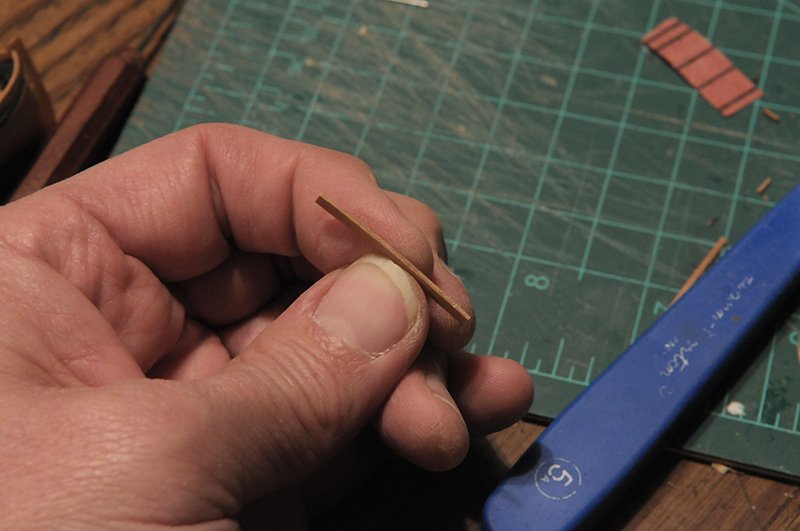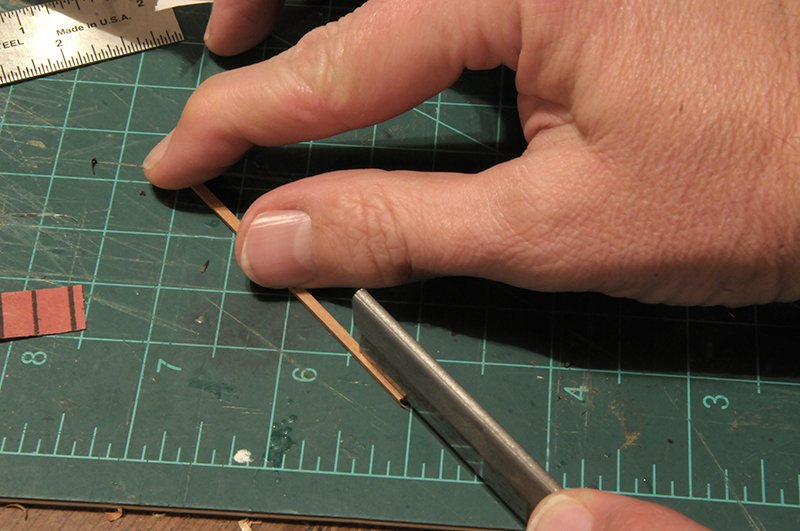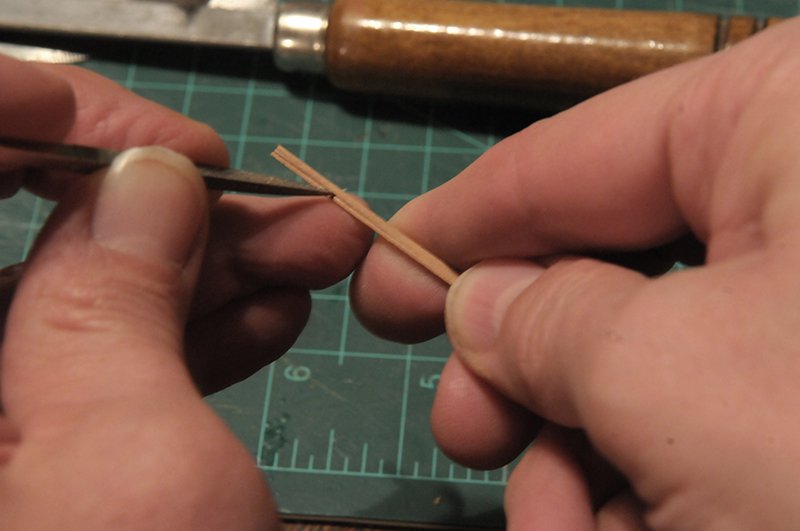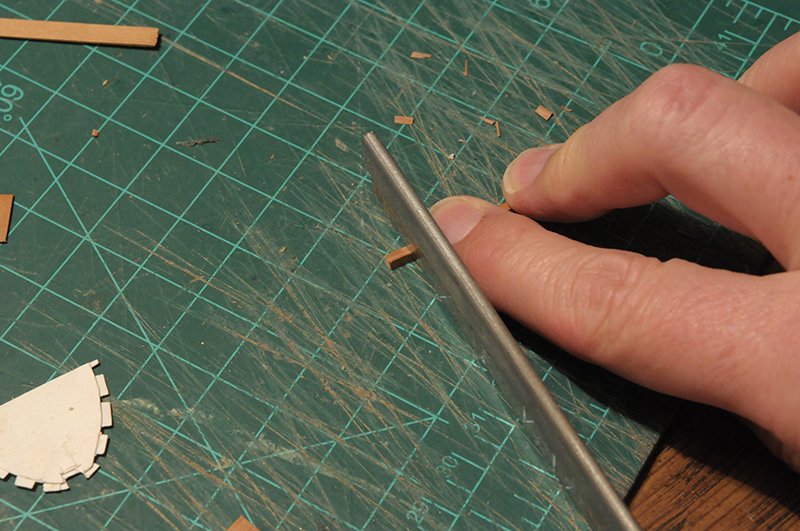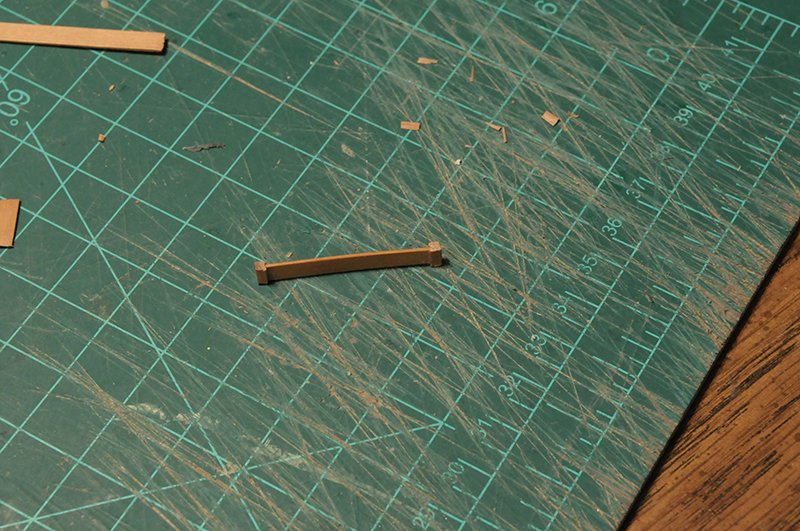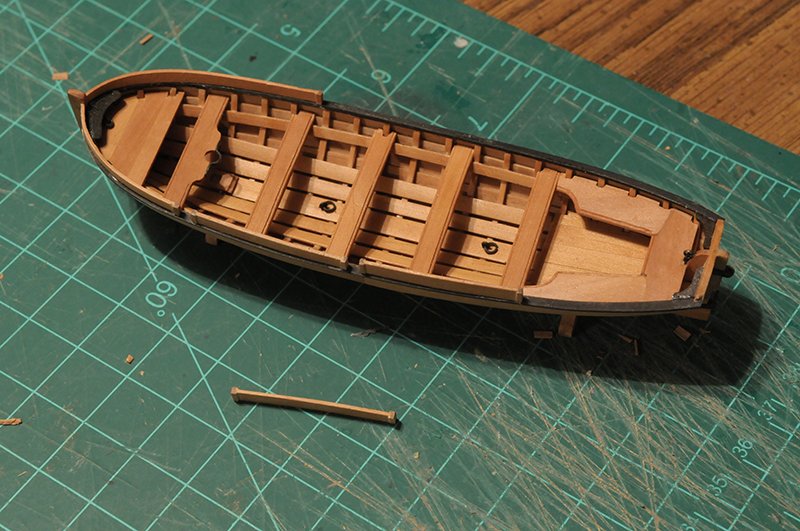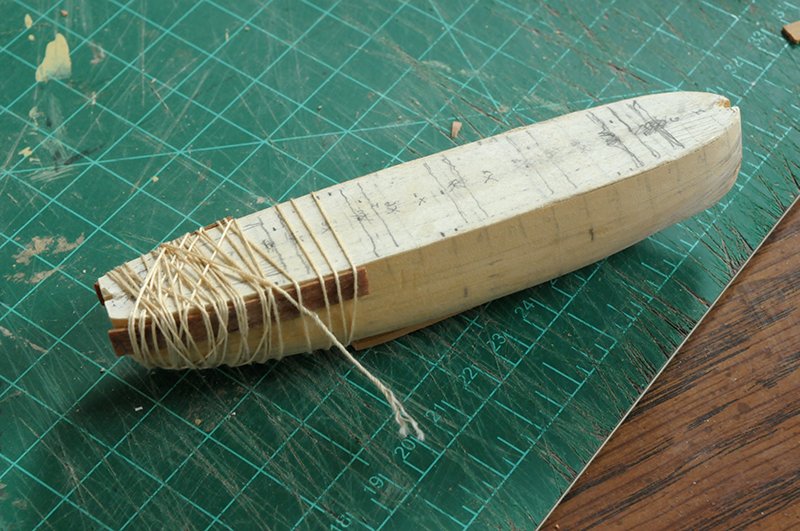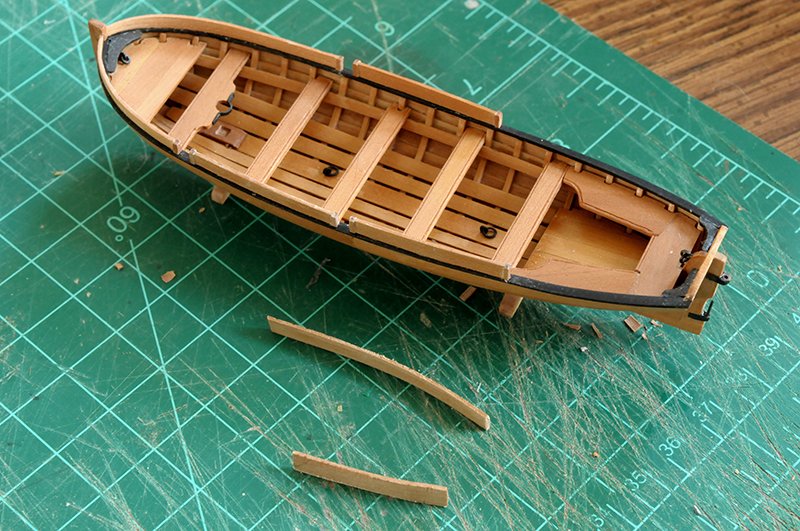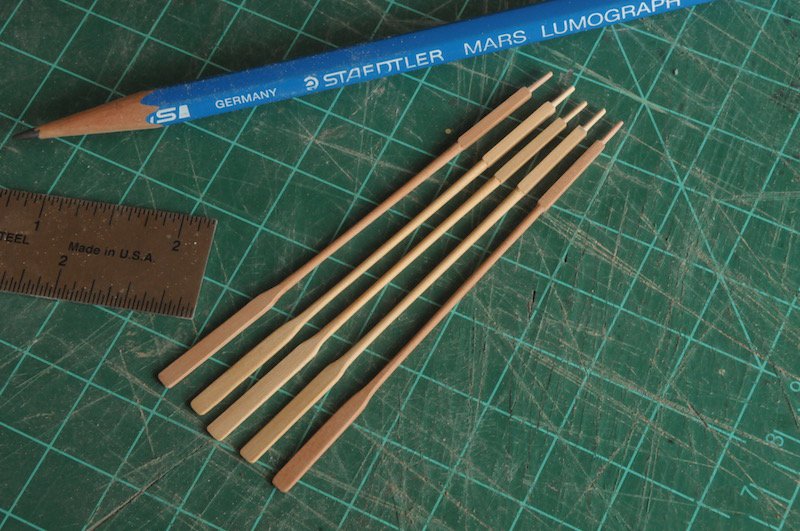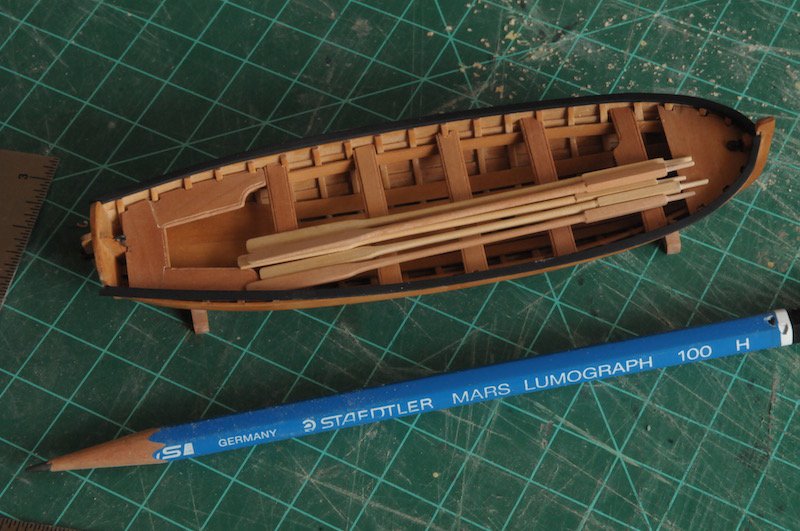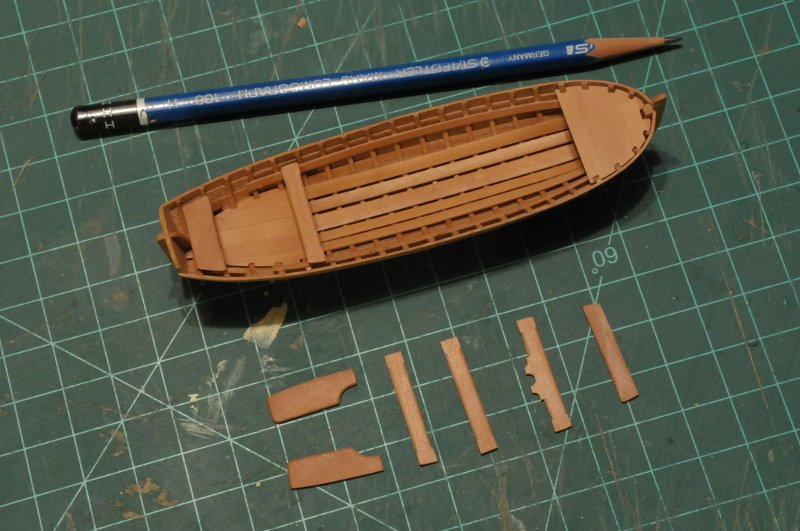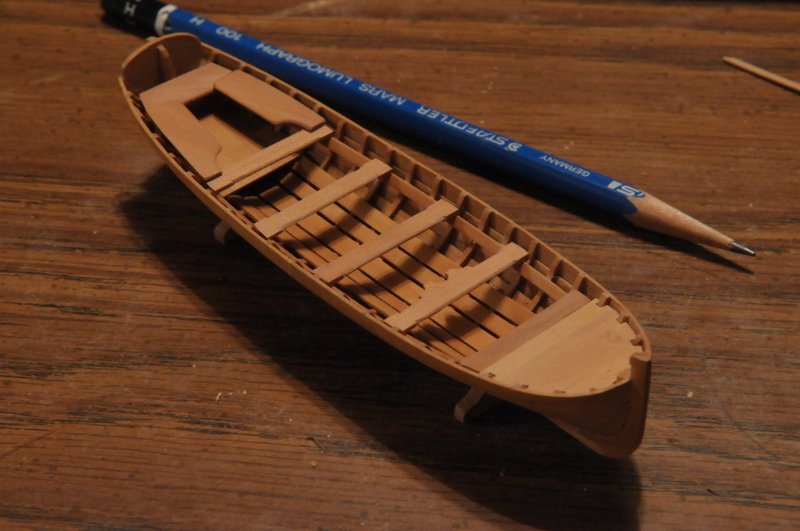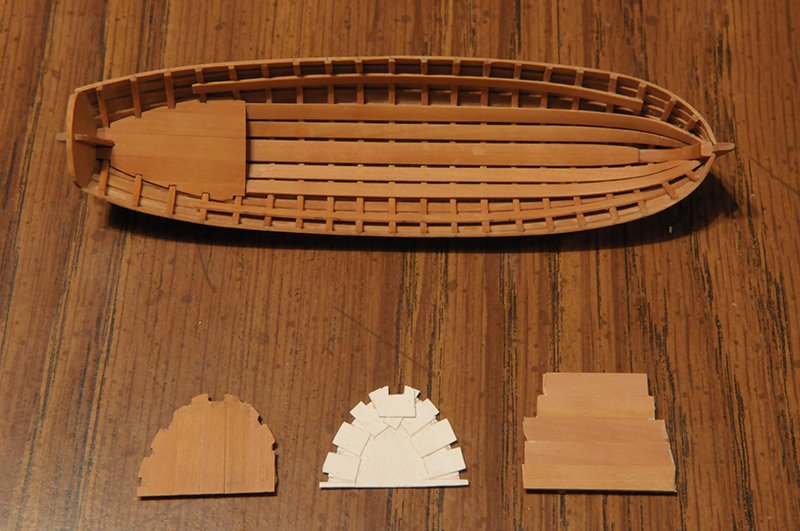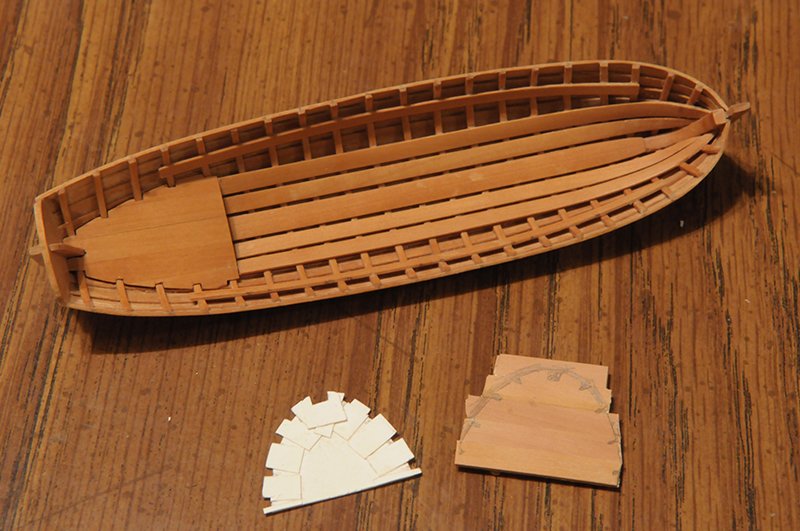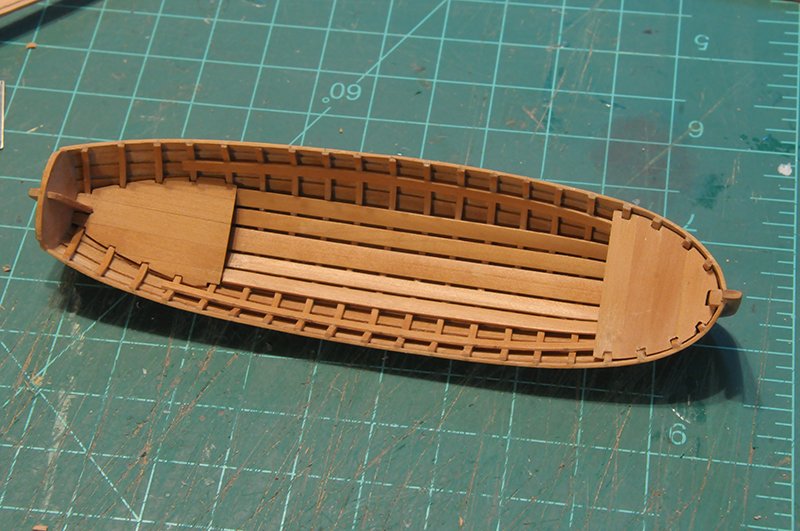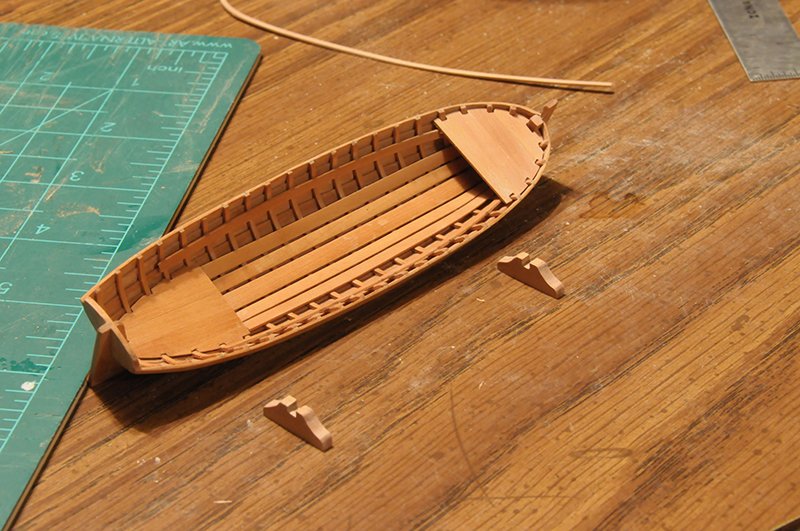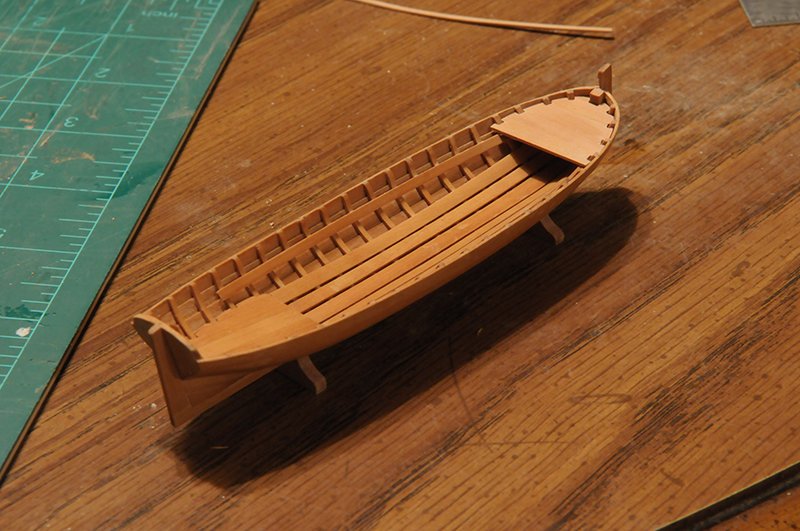-
Posts
655 -
Joined
-
Last visited
Content Type
Profiles
Forums
Gallery
Events
Everything posted by rlb
-
How much can I bore you with incremental progress!? Here is the tie-down, ready for further work-- One end is "seized" (I don't know the proper term)-- And back in place, rope is (at the other end) thread through the eye splices-- And the wire cut-- Just to end with something interesting, while glue on the knots dries, a shot looking down the deck-- Ron
-
Hi Hamilton! Thanks for checking in. Lou, batten, yes, that sounds good to me. So, a small update. I am not able to spend a lot of time on the model--maybe an hour or so every couple days. Work continues on the battens and tie-downs. I cut a couple lengths of rope and gave them a dipping to darken the thread a little-- Then draw across some beeswax-- After making a simulated spliced loop in one end, I test fit the rope on the batten to get an approximate length for the loop at the other end of the rope-- Once I had the two loops, I connected them with a bit of wire to test the length. I'll finish the one on the right before going any farther with the second one. Need to make sure this will work! Testing the fit again on the model. I put a small dab of glue just on the rope where it turns down off the batten. Hopefully it will hold it's shape after I take it back off the model to work on lashing the two loops together. I'm not sure yet whether I'll finish that lashing completely off the model, or try to tighten it on the model-- Ron
-
Thanks Bossman, Martin, John, and Lou, and everyone who hit the "like" button. I'm glad you guys are still around and watching! Work continues on the tie-downs for the boat. I cut a couple of pieces--not sure what you would call these--but they will notch into the wales of the boat and guide the ropes that will tie it down. After rounding the ends, a shallow groove is filed into each end-- And on the underside, two notches are filed-- They fit across the boat like this== You can also see the ringbolts placed in the deck that the ends of the ropes will be hooked into-- That's all for now! Ron
-
Another New Year, another New Year's Resolution (among others). I moved last year. Here's my new workshop--I don't need to use the dining room table anymore-- I finished the splash boards on the ship's boat, and put pins in the deck support pieces-- If you are very observant you will notice only 4 oars, but 5 rowing locations. Somehow I lost an oar in the move to my new house!!!!!!!! I can't believe it. I'm not sure whether I will make a replacement oar. (but should, and probably will) Drilled the corresponding holes on the deck for the boat supports- And here they are glued in place-- The boat in place-- Next will be placing the tie-downs for the boat. I vow to continue working on this model longer than I did last year! Ron
-
Captain Poison, Thank you for the additional information! The Quebracho table is beautiful, the wood has a very rich color. You prompted me to do some more research, and I must correct some of my information. I do not think that the powder I have is from the bark of the tree. It is a water soluble extract made from boiling chips of the red heartwood of the tree, which contains the desired tannins. At the taxidermy supply retailer I purchased it from, it is called "Bark Tan", which led me to the wrong conclusion. It seems to be used most commonly in this form to dye leather. As pointed out by Captain Poison, and apparent from the label on the box, it's to be used with care. Here is a photo of the label, and the bag of Quebracho Extract-- Lou, I am only too happy to oblige! Here is an overall photo of Oneida (sorry for the dark lighting, a daytime shot would probably be nicer)-- And a closer view with the unfinished boat in it's stowed (proper term?) location-- Ron
-
Thanks, Ed! Captain Poison- Thanks for the info and translation of the Quebracho tree! I knew it was from South America, but not much more than that. What I have is a plastic bag of powdered bark from the tree. I learned of it's use from a woodworking magazine article on ebonizing wood. I don't remember where I purchased it from, but found it from an internet search. There is probably at least a pound of it in the bag (the bag was shipped in a 5 inch x 5 inch cardboard box), enough to last a lifetime and more of model making, as I only need a teaspoon at a time! Ron
-
Thanks Martin, and to all for the likes. Amazing how time flies by. I am still working, though at a snails pace for the last couple months. Here's a little bit on how I am making the splash boards: First a blank piece, slightly curved (by bending with my fingers, no additional heat needed) to match the gunwale-- Next, a groove is cut in a piece of square stock-- This groove is widened a bit with a file-- And cut into short sections-- These are glued to the ends of the splash board (which has been "pointed" on the ends with a file, to fit the grooved pieces-- The end "supports" are oversized (only to make them easier to handle) and need to be filed and sanded down to size-- The assembly needs to be very slightly sanded on the bottom to match the slight sheer of the gunwale. Once they are all glued on, I will sand them all down to the right height (as attached they are too tall). The last two boards are more curved, so they are boiled and bent to the original plug-- These two now need end supports on the forward ends. As with the other splash boards they will be sanded down to the right height once glued on-- The little boat is slowly getting there! How long has it taken me to build this? Three years?! Ron
-
Martin, I'm just catching up on all you've done on Fly the last few years. Great job! Ron
- 467 replies
-
- fly
- victory models
-
(and 1 more)
Tagged with:
-
Thank you, Russ. I do feel good about the oars. I was dreading them, but as is usually the case, once you get started, the rest follows. Not much happening since Christmas, but I'll start the new year off with a post. I had to remove the partially epoxied gunwales. The curve of them wasn't an exact match to the hull, and I thought I could bend them as I glued them incrementally. No go, there was too much curvature at the aft end. The pencil line shows the actual curve taken off the model, compared to my piece-- It doesn't seem like much, but as it's curving against the wider dimension, the force was too difficult for me to deal with. So, I submerged the removed wale in heated water, and edge bent it carefully with my fingers, heat-bend, heat-bend, numerous times, checking against the boat, until the curve was good, and I could glue them all in one shot without forcing any bends. Next was shaping a breast hook and two stern hooks (?)-- These were blackened, along with a deadeye that missed out when it was his brothers' turn-- They are now glued, with the gunwales-- Finally, the splash boards are being fitted, and glued-- Happy New Year all! Ron
-
The oars are 95% done. Some fine-tuning to the shoulders of some of the blades, and a little further reduction in the handle diameter will finish them for me. The color variation is a little bothersome--they were all cut from Castello Boxwood, but a couple are as dark as the Pear. The oar on the right was the first one, and it has a slightly smaller shaft diameter up near the loom, which I think is too small. I made the others a little beefier-- Happy Holidays, all, Ron
-
As usual, in making the oars, I have charged off, having an idea of what I'm doing, but not full knowledge. And as with most things in the model, as I get into the task, and questions arise, I spend time hunting for answers, and learning. I started by eye, from a few model photos (and particularly dangerously, memories of model photos), and a chart in May's book which listed a 13 or 14 foot oar (I don't understand the dual listing for all the oars in the chart) for a 20 foot cutter, which is what I have. Being somewhat dissatisfied with the progress on my little oar, I was able to find online an excerpt from David Steel's The Art of Making Masts, Yard, Gaffs, Boom, Blocks, and Oars, from 1797. It gave dimensions for the various parts of the oar, which was a great help. The smallest oar it listed was a 16 footer, but close enough. I was able to fine tune my proportions. Among other things, I squared off the loom portion (yes, I learned the proper term) to get it to a more correct dimension. The blade became much narrower also. It's still a bit too wide, maybe a hundredth of an inch or so. And the handle should be thinner. But I am stopping here in fear of breaking it. Once I get a few more done, I may come back and fix those discrepancies, or maybe I will just bury this one in the bottom of the bundle when they are all stored in the cutter-- Observant folks will notice which mast step I decided upon. Ron
-
Staining the boat's gunwales, and the ship's deadeyes. In the coffee cup is the Quebracho bark "tea". In the small shallow bowl is the rusted-nails-in-vinegar solution (with bits of rust swimming in it). The procedure is to soak the pieces to be stained in the bark tea, then paint them with the rusty nail liquid. Here I have put the deadeyes on a paper towel after dumping them in the coffee cup and stirring them around for a minute-- I painted the bark tea on the boat gunwales with a q-tip-- With the deadeyes, I dumped them into the rusty nail solution, then fished them out and got a fresh bowl of solution to paint the gunwales with. If the rusty solution gets contaminated with too much of the bark solution, it doesn't work well. Here the gunwales are epoxied at the bow, and left to cure. My plan is to incrementally epoxy them from bow to stern. You can't seem much detail in the deadeyes, the ebony stain worked quite well-- Five oar blanks out of castello boxwood. I'm wondering if I can really make some nice oars out of these-- I started by chucking one in a hand drill, and sanding it round, close to the diameter of the weighted part near the hand grips. From there, I'm shaping it by hand with files and sandpaper. I feel like this is going to snap at some point, as the diameter reduces-- This is going to take a while-- In between working on the oars, I'll be working on some other things for relief. Probably the ship's lower masts, as they will help me in making the channels and chainplates. Ron
-
Modifications to the sternpost to accommodate the pintles and gudgeons-- Rough shaping of the rudder-- And after modifications for the pintles and gudgeons-- Silver soldering the two pintles-- The tiller is an iron rod with a ball shaped handle at the end. For the ball I initially started shaping the corner of a hunk of brass-- Before long, I realized that maybe this was not the best way to do this. I thought of an alternate idea of soldering a short section of brass tube at the end of the tiller brass rod-- It was easy then to shape it into a ball-- Here are the tiller, eyebolts, pintles and gudgeons, and the mast keeper, ready to be blackened-- The tiller-- Here is the rudder with all pieces attached-- And held next to the boat-- It can't actually be "shipped", though it is very close. It doesn't matter, as the rudder will not be mounted, but will sit in the back of the boat, as it's lashed on deck. I realize the pintles and gudgeons are a little over scaled, and I could do better if I scrapped them and tried again. But I think this will have to do. Here is the boat with the thwarts, seats and bow platform glued in, as well as the eyebolts. (Except the stern one, which went missing right when I had the epoxy mixed up-fortunately I later found it--it is there in between the rudder and mast steps.) The mast step--type 1, round (which was miraculously also found) and type 2, square--is yet to be decided upon, and glued. The gunwales are roughed out, they will be dyed black before installing-- Ron
-
Thanks, Ken. I agree, and I have used steel wool in the past. But I have a tin can full of old nails from various home renovation projects, which I have saved for this specific purpose! The concoction is brewing-- Mostly preparatory work happening. Nothing being finished, but if I can consistently spend some time, it's all progress. Thickness sanding some stock to use for the rudder-- Wrapping wire around a drill bit will become eye rings to go in the boat, and wherever else needed-- And cutting some brass sheet for the mast "keeper" and pintle and gudgeon ironwork-- Onward, Ron
-
Dave, good luck with your builds, sounds like the variety helps. I was looking through W E May's book The Boats of Men of War for some general guidance, and this illustration caught my eye. Though this is for a different sailing rig, with two masts vs. my single mast, the way the mast steps were drawn made me doubt my version of the mast step. This was more rectangular, which makes sense as it gives an area fore and aft to fasten the step to the floor/keel. And on the thwart, I noticed the transition curve was concave (ironically more like my first version) rather than convex-- I also thought maybe my round step was a little too fancy. A simple square mortice might be more practical, and that's the way the ship's mast steps are as well-- I will leave it this way until time to glue. Leaves both options open as well. I have a weakness for delaying decisions as long as possible! Here's the correction to the mast thwart-- And here's the beginning of the ebony stain "soup". Some rusty nails need to sit in vinegar for a while-- Ron
-
Dave, I've noticed the steady stream of likes going back in the log, thanks! I think you've got me on the bits. You are probably right that they wouldn't just sit on the deck the way I am doing them. I hadn't thought about that, except to pin them for holding resistance on the model. I would love for this model to be accurate in all ways, but my knowledge and resources are not as complete as I would like them to be, or as it may look. I'm constantly learning (which is one of the things I love about this hobby), and learning what I've done wrong! Some things bubble up to the do-over status, some stay "I'll do it more accurately next time". Thanks for looking in and commenting. Ron
-
The third try on the mast support thwart was acceptable-- For the first two, I glued a small piece on to the standard width thwart. Easier to shape that way. On version 1 the wood matched perfectly, you can't tell it's added on. But I didn't like the shape, or the rolled edge of the thwart. On the second, the color didn't match well, and you could see a slight joint gap because I didn't have the faces perfectly square, (light sawdust is filling the gap in in the photo). The shape is okay, but the final straw was when I chipped a part of it trying to speed things up with a blade instead of a file. On the third try, I started with a wider piece--obviously more material to remove, so a slightly more complicated process, but successful in the end. The thwarts have been shaped and cut around the frames-- Making another mast step-- Here's how Oneida's boat looks after cutting the edge profile on the thwarts and fitting them in place (not glued yet). This time, I will not cut the mast step from it's "handle" until I'm ready to glue it!-- The angle and shadows of this photo do a really good job of hiding a lot of imperfections! Believe me, they are there. Next will be making the rudder, some iron work, and the oars. I'm also starting to cook up another batch of ebony stain for the "gunnels" on this boat, and while I'm at it, the deadeyes for the ship. Ron
-
Thanks, Russ. Ed (Ebomba) and hamilton, I'm glad you are still here to follow the continuation of this model. I now feel a strong desire to finish, so I hope it will keep moving. Here's just a tidbit, hopefully I'll have more to post sometime this weekend. Rough cuts of the thwarts, and notice I have cut back the bow piece to more closely match the layout sketch I originally made on the plug-- I keep looking on the table, and the floor, for the AWOL mast step (It's GOT to be here SOMEwhere), but as you said Russ, It'll be quicker to just make another one. Dang. Ron
-
Do-overs. I wasn't happy with the way I did the seats and thwarts. I followed a mixture of sources, but after studying more examples, it seemed a mess. And I don't know where I came up with the shape of the thwart that supports the mast. It seemed reasonable when I made it, but not so much now. I made another template for the seats. This time I will cut out the frame notches (as I will for the thwarts also). I hoped that I could re-use the side seats, as they were wider than I liked (now with notches cut in, they would, in effect, become narrower). The back seat will have to be a new piece. Also, take note of the mast step sitting there in the boat, not glued yet-- Instead of laying the side seats on top of the back seat, as in the previous version, I wanted to make a single u-shaped bench-- And instead of the simple rolled edge that I had made for the seats and thwarts before, I opted for a more detailed, scraped profile edge-- So far so good-- Unfortunately, during the numerous test fittings, the little mast step piece went missing. So, unless I miraculously find it, that will be another do-over. Ron
-
Thank you Russ and Martin, nice to hear from you both. Andante, thanks. Good to know you have a record! Work continues on the cutter. I've spent just a little time most days this week. At least it's progress! Making the seats and thwarts-- They are test fit here, not glued yet-- Still many parts to make. Ron
-
Greetings, everyone. Soon didn't turn out to be soon. It's inconceivable to me that it has been three years since I last worked on Oneida. But here is something new, work continues on the ships boat-- On the left is my first attempt at the bow platform--disastrous. Then I got a little smarter and made a heavy paper template, made up of a central shape fitting within the frames, and then gluing pieces on to create the notch spacing, as I test fit it. On the right is the new blank to be cut-- Next is the template traced on the blank-- And in place-- Then I carved and sanded two supports that will be used to house the boat on the ship's deck-- That's all for now Ron
-
Hi B.E.-- Beautiful work on the ship and display, congratulations!! Ron
- 366 replies
-
- pegasus
- victory models
-
(and 2 more)
Tagged with:
About us
Modelshipworld - Advancing Ship Modeling through Research
SSL Secured
Your security is important for us so this Website is SSL-Secured
NRG Mailing Address
Nautical Research Guild
237 South Lincoln Street
Westmont IL, 60559-1917
Model Ship World ® and the MSW logo are Registered Trademarks, and belong to the Nautical Research Guild (United States Patent and Trademark Office: No. 6,929,264 & No. 6,929,274, registered Dec. 20, 2022)
Helpful Links
About the NRG
If you enjoy building ship models that are historically accurate as well as beautiful, then The Nautical Research Guild (NRG) is just right for you.
The Guild is a non-profit educational organization whose mission is to “Advance Ship Modeling Through Research”. We provide support to our members in their efforts to raise the quality of their model ships.
The Nautical Research Guild has published our world-renowned quarterly magazine, The Nautical Research Journal, since 1955. The pages of the Journal are full of articles by accomplished ship modelers who show you how they create those exquisite details on their models, and by maritime historians who show you the correct details to build. The Journal is available in both print and digital editions. Go to the NRG web site (www.thenrg.org) to download a complimentary digital copy of the Journal. The NRG also publishes plan sets, books and compilations of back issues of the Journal and the former Ships in Scale and Model Ship Builder magazines.



